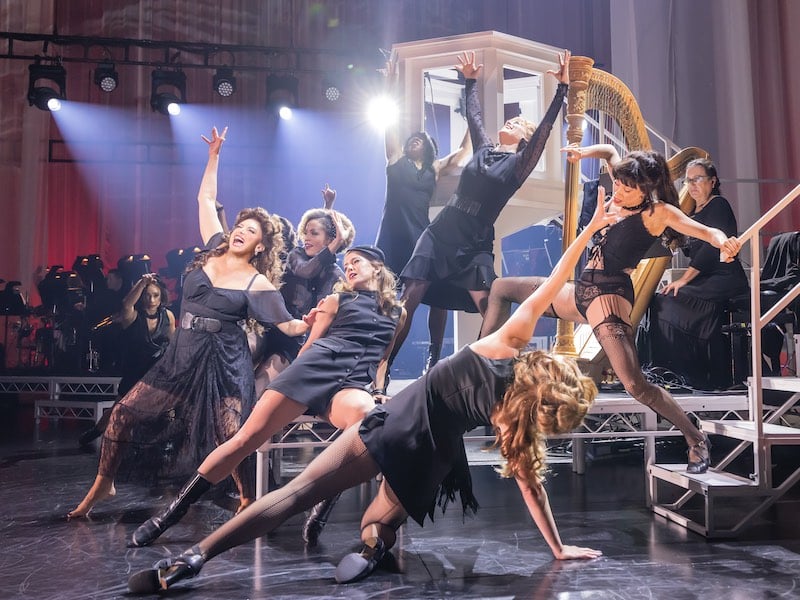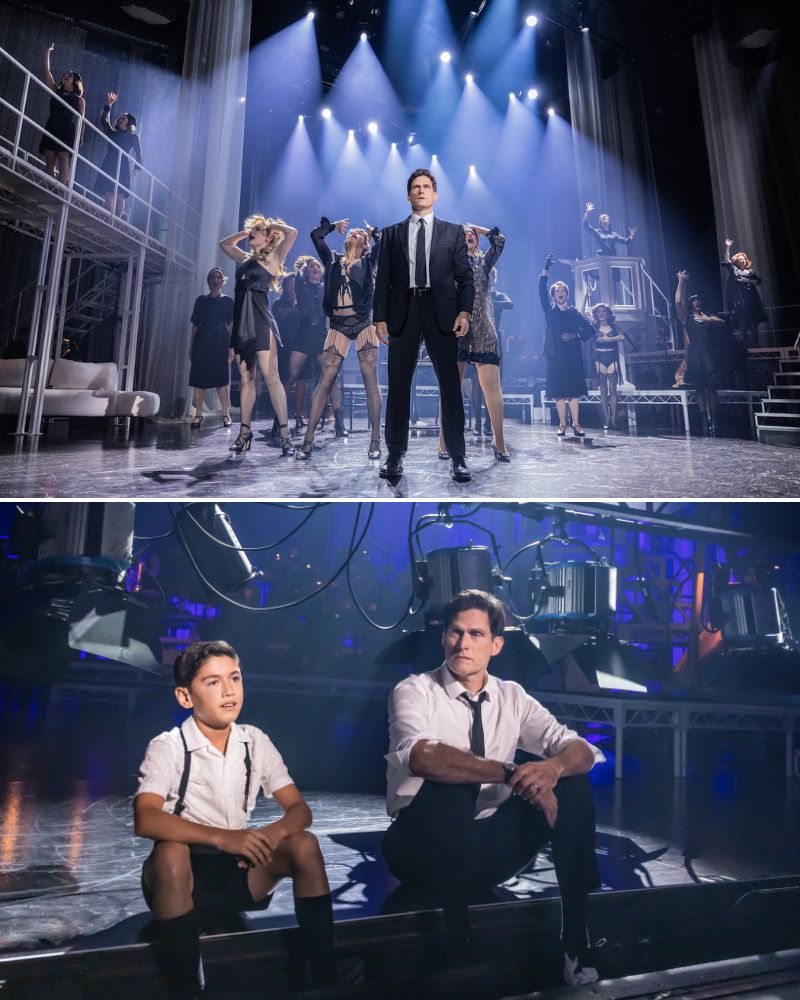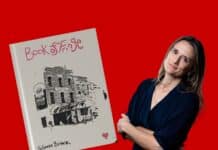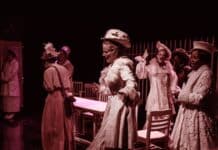With the time, expense, and resources — not to mention creative and collaborative demands — that it takes to build a new Broadway-caliber show from scratch, producers have relied on revivals for decades now. No matter that each such revived Broadway show is a product of its time, its political and societal mores.
Through August 11, Kennedy Center’s Broadway Center Stage is remounting Nine — the 1982 Arthur Kopit/Maury Yeston musical homage to film auteur Federico Fellini’s 8½ (1963). Under the keen eye of director/choreographer Andy Blankenbuehler — best known and admired for his work on Hamilton — this staging is chic, smart, and lively, hewing to its Felliniesque inspiration and fashionable Italian design aesthetic.

Nine is an apt story of the joy and pain of honing the creative process as told through the life of Fellini doppelganger Guido Contini, an Italian filmmaker who hasn’t had a breakthrough in years. Contini was a hitmaker, a star-maker, a changemaker, but at 40 he’s lost his flow. Steven Pasquale’s Guido leans into his Italian machismo and insatiable appetite for women, yet at some key moments of emotional grist, he finds himself woodenly clueless to anyone’s feelings other than his own. As nine-year-old Little Guido, Charlie Firlik is still a boy soprano but a star in the making. He imbues the role with mischievous, childlike wonder, and when older and younger Guidos duet in “Be Italian” and then in “Getting Tall,” both actors sparkle and real emotional intelligence shines through.
The all-woman supporting roles and chorus are both at the service of Guido’s desires and needs but are also present to underscore the protagonist’s flaws, particularly his narcissist qualities. As Guido’s steadfast wife Luisa, Elizabeth Stanley becomes her husband’s explainer in Act One’s “My Husband Makes Movies.” But as she is forced to contend with his wandering eye for beautiful and seductive women, she faces off with his lover Carla (Michelle Veintimilla) in a choreographed pas de trois that demonstrates the backpedaling maneuvers her husband is so adept at. As Guido’s Mother, movie actor Mary Elizabeth Mastrantonio imbues the character with more wryness than the Italian gravitas that Sophia Lauren carried in the 2009 movie version.
The other star of this production is the 12-woman chorus, who shape-shift in and out of supporting roles, occasionally conducting the onstage orchestra and performing through the many dream and flashback balletic sequences that keep the ensemble in near-constant motion. Then of course there are the flashy moments, particularly the sequined and feathered duo beside Carolee Carmello’s Edith Piaf–like rendition of “Folies Bergères” as Liliane La Fleur and the equally rousing and sexy tarantella-ish song and dance number “Be Italian,” tracing Guido’s origin story to Little Guido’s encounter with a beach-dwelling prostitute, Sarraghina, the voluptuous and earthy Lesli Margherita.

Set designer Derek McLane smartly leaned into an unfinished soundstage setting with a visible grid of lights, and gauzy white curtains sheathing and revealing bare backstage walls and wings. The well-dressed Kennedy Center Opera House orchestra, in black designer-like togs, directed by Lily Ling, played primarily from an upstage corner, shifting the perspective of the set onto a diagonal, making the space feel slightly off-kilter in perspective and eminently more interesting visually. Alejo Vietti’s costumes — mostly little black dresses, some shifts, some clingy, with touches of white in the men’s shirts — were also a nod to Fellini’s black-and-white cinematography. The women’s dresses and shoes were all impeccably cut and styled, some modest, others curve-enhancing, with black stockings and revealing garters. As well, Tom Watson’s hair and wig designs paid homage to the 1960s with bouffants and long Breck Girl cuts, while still feeling fashionable today.
In all, this new Broadway Center Stage production of Nine is exceedingly attractive and determinedly of its times in theme and scope. It’s well-sung, beautifully choreographed, musically strong, and filled with fashionable flair and chic design choices. Each of Guido’s women — his wife, his lover, his movie star, his producer, his mother — has her moment, but this is Guido’s life, his story for all its intrigue and his many flaws. Foremost, Nine scaffolds its singular male protagonist Guido Contini into a Felliniesque 1960s period piece. But it also hews to its early 1980s creation, as well as Fellini’s focus on what British film theorist Laura Mulvey has termed the “male gaze.”
After the #MeToo era — kicked off by the egregious and criminal actions of Harvey Weinstein, whose company produced the 2009 Rob Marshall movie adaptation — reviving Nine feels, at least for this reviewer, a bit fraught. The question arises: “Why now?” Is there more to say? Does Blankenbuehler’s iteration pay justice to the women’s stories, or only to Guido’s? It gamely tries, and each woman has her moment, particularly Luisa, but the musical feels like a period piece and a stuck timepiece. Maybe the best way to attend to its glaring inequities is to enjoy the journey while being reminded that there’s still work to do in the world. Nostalgia for the male gaze and sexist, antifeminist tropes is so 1982.
Running Time: Two hours and 10 minutes, including one 15-minute intermission.
Nine, a Broadway Center Stage production, plays through August 11, 2024, in the Eisenhower Theater at the Kennedy Center, 2700 F Street, NW, Washington, DC. Tickets ($59–$299) can be purchased at the box office, online, or by calling (202) 467-4600 or toll-free at (800) 444-1324. Box office hours are Monday-Saturday, 10 am-9 pm, and Sunday 12pm-9 pm.
The program for Nine is online here.
COVID Safety: Masks are optional in all Kennedy Center spaces for visitors and staff. If you prefer to wear a mask, you are welcome to do so. See Kennedy Center’s complete COVID Safety Plan here.



